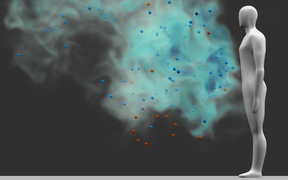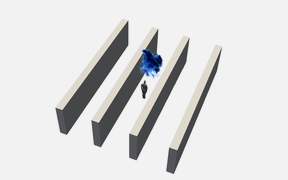New simulation code to eliminate need for super computers in modelling indoor aerosols
The simulation code shows how air circulation affects aerosol spread on a bus. Simulation and visualisation: Ville Vuorinen and Heikki Kahila, Aalto University
Assistant Professor Ville Vuorinen is developing a code to vastly improve how aerosol clouds are modelled, allowing even regular desktop computers to compute the currently lengthy calculations. Aerosols are tiny airborne particles that carry pathogens, like SARS-CoV-2 virus.
‘There’s increasing research evidence that aerosols play a strong role in spreading the Corona virus. Normally modelling aerosol movement requires a super computer and, even then, it takes several days. Our program makes use of graphics cards from the gaming word, which can add so much computing power to a regular computer that we can get a result in as little as one hour,’ Vuorinen says.
The program takes into account the number of people and their positions, in addition to calculating how the space itself and ventilation systems affect how aerosol clouds form, spread, and dissipate. When ready, Vuorinen intends to make the code openly available.
‘Through this 1.5-year project we’re modelling various public spaces from sport events to public transport and schools. Our approach could offer solutions to keeping society open during a pandemic. We’ve set out to make an effective and versatile tool available in at least one programming language that helps researchers and other professionals,’ he explains.
Vuorinen is focusing on modelling indoor spaces, where the risk of an aerosol-based infection is significantly higher.
‘Aerosol concentrations easily increase in closed environments, especially when there are a lot of people gathered and there’s loud talk, yelling or singing. During an epidemic it’s wise to avoid these spaces or minimize your time there, even while wearing a mask,’ he says.
Last spring Vuorinen’s team, in collaboration with researchers from other Finnish institutions, discovered how differently sized aerosol droplets behave in the air. Until then, it was assumed that only very small, under-5 micrometre droplets stay suspended in aerosol clouds.
‘Our study found that larger droplets – as big as 50-100 micrometres – can rapidly dry up before they reach the floor and linger in the air. This has major implications for the ventilation and air circulation of public spaces, as well as for mask recommendations,’ Vuorinen adds.
The project received funding from the Academy of Finland in spring 2020.
Read the study from last spring: Modelling aerosol transport and virus exposure with numerical simulations in relation to SARS-CoV-2 transmission by inhalation indoors(sciencedirect.com)

Modelling confirms: Isolating the ill and prioritising remote work are key strategies in combating the coronavirus
Researchers emphasise that longer indoor exposure times and closer proximity to others bring greater risk of infection. Avoiding overlapping shifts and a good ventilation can improve workplace safety.

Researchers modelling the spread of the coronavirus emphasise the importance of avoiding busy indoor spaces
A joint project carried out by four Finnish research organisations has studied the transport and spread of coronavirus through the air. Preliminary results indicate that aerosol particles carrying the virus can remain in the air longer than was originally thought, so it is important to avoid busy public indoor spaces. This also reduces the risk of droplet infection, which remains the main path of transmission for coronavirus.

Read more news

Aalto Inventors innovation training coming for hydrogen, quantum and microelectronics researchers this spring
Connect with industry and academic thought-leaders and gain widely applicable skills in communication, intellectual property, and business.
Start the year with new insights – apply for FITech's spring courses!
Deepen your knowledge with courses from Finnish universities of technology, designed to meet the demands of the working life and help deepen your expertise for free.
Combining studies in technology and business allows Kriti Bojja to navigate multiple career directions
Kriti Bojja is excited about the variety of career opportunities the Digital Systems and Design major will allow her to pursue






